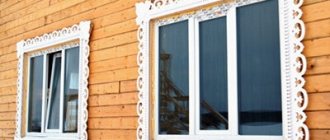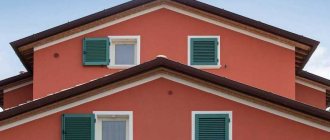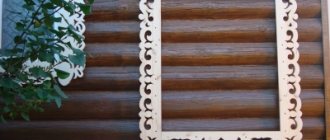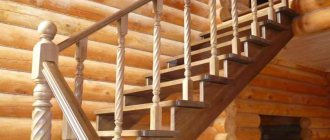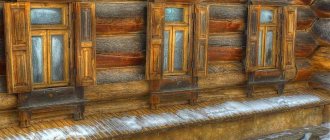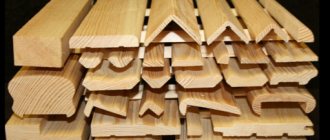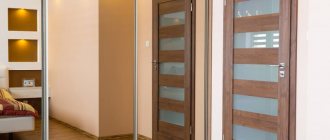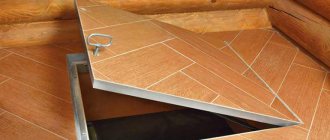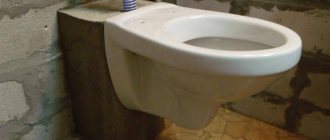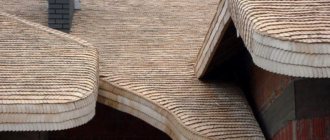Protecting the window opening is a mandatory action after installing a plastic structure.
It is necessary to take a responsible approach to the choice of material.
This will increase the service life of the slopes and the performance characteristics of the entire block.
Let's take a closer look at metal slopes and their installation on PVC windows.
Purpose of devices
External metal slopes for plastic windows are designed to protect polyurethane foam from ultraviolet radiation, precipitation, and being carried away by the wind.
If the foam is not covered, in a few years the material will be damaged, cold air will begin to enter the room, and the walls will become damp, increasing the risk of mold. After installation, it is necessary to install slopes on new windows; most often they are also plastic, less often metal. It is better to use metal to improve the interior. It is able to reliably and efficiently isolate the opening from external influences.
Metal slopes for plastic windows must be installed immediately. Many homeowners do not do this, believing that foam will cope without protection. This opinion is incorrect. The main reasons why installation is required immediately:
- Aesthetically, the structure looks unattractive; the façade of the building looks untidy.
- Polyurethane foam will deteriorate under the influence of sun, wind and precipitation.
Foam is not capable of acting as waterproofing; it must be protected from moisture, otherwise moisture will be absorbed and the window will freeze in cold weather. If for some reason the installation of metal slopes is not possible immediately, for example, the building is being renovated, the installed windows with fresh foam must be covered with at least plastic film until the slopes are installed.
Ready-made metal slopes
Requirements
Products must meet the following specifications:
- Be durable. To do this, you should choose a material with a high-quality coating.
- Match the style and design of the glass unit and the building as a whole.
- Fully perform the functions of protecting the window opening from moisture and cold.
Among the regulations, it is necessary to follow GOST 30971-02, GOST R 52749-2007, SNiP 3.04.01-87. If you decide to entrust the installation to professionals, then you need to conclude an agreement. It must contain a paragraph indicating the regulatory documents that guide them in the process of work.
Why is it recommended to use metal for slopes?
To protect the polyurethane foam, you can use plaster mixtures, plastic panels, paints and varnishes; if the work is carried out indoors, drywall will do.
Metal slopes for the façade side of a building are most suitable, since this material does not burn, is resistant to any weather conditions, and if stainless steel is used, you do not have to worry about the corrosion process.
The plaster can crack, and when it comes into contact with a PVC frame, condensation often occurs, which harms the walls and the plaster itself, and can cause mold to form. Drywall is afraid of moisture and is destroyed by it, so it can only be used in a dry room; It is unsuitable for the street, as it quickly deforms from precipitation, swells and collapses. Plastic can be used: it is much cheaper than metal, but it is worth remembering that this material does not like temperature changes and becomes more fragile. The mechanical impact of wind can break such panels.
Metal slopes are usually made of galvanized steel: it does not rust and is not afraid of mechanical stress. The material is covered with a special protective layer of polymer on top. It not only preserves steel from the influence of nature, but also allows you to achieve a neat decorative appearance of slopes.
Material for slopes – galvanized steel
How can you seal window slopes from the outside?
From the outside, the structure can be sealed with a variety of different materials. Suitable:
- plaster mixtures;
- PVC panels;
- siding;
- metal;
- clinker tiles;
- drywall;
- sandwich panels;
- expanded polystyrene;
- wood;
- natural stone.
Slopes provide additional insulation of walls and windows.
Plaster
Decorating with plaster is a traditional, most economical, easy-to-use finishing method. Dry building mixtures are used for it, but the process takes longer than other options. As a finishing decoration, additional painting is done.
Plastering is the most economical way to finish slopes.
Plastic
Plastic slopes are perfectly combined with metal-plastic windows; they are easy and quick to install, including with your own hands. The material is distinguished by high heat-insulating properties, resistance to “cruel” natural phenomena - it is not afraid of high humidity, and does not deteriorate in severe frost. The product improves sound insulation, is compatible with all types of insulation, and does not require leveling before starting installation work. The use of foamed PVC panels additionally insulates the room; the material does not flake when exposed to high temperatures, and does not lose shape from cold and moisture.
The use of sheet plastic allows finishing work to be carried out as quickly and accurately as possible.
Siding
Decorating with siding is one of the budget, but not very durable options. The cellular structure of the material leads to the fact that the slopes gradually become deformed, turn yellow, and swell. Since the siding is hollow, it will provide little protection from the cold; an additional heat-insulating layer is required underneath it.
The material allows you to quickly create an aesthetic coating that has a certain level of thermal insulation and soundproofing.
Drywall
The main disadvantage of drywall is its ability to absorb moisture, therefore, when decorating external slopes with it, the surface is additionally puttied and painted. The material is recommended for finishing windows facing glazed balconies, verandas, loggias.
It is also quite suitable for cladding external slopes if the windows overlook a glazed loggia, balcony or terrace.
Sandwich panels
Such three-layer panels, consisting of two layers of plastic and a sheet of insulation (extruded polystyrene foam), are optimally suited for decorating the sides of a window opening. Thanks to them, the opening receives something like a “thermal coat” with high sound insulation. Sandwich panels are similar in appearance to plastic panels; they do not need additional decor. Installation of such slopes requires strict adherence to the instructions, and it is better to purchase the parts ready-made.
They have low thermal conductivity and do not require additional finishing.
Styrofoam
Insulation using polystyrene foam is a simple and cheap option. This material retains heat well, it is low-flammable, lightweight, and easy to cut into any shape. For work, a product with a thickness of two cm and high density is used. Expanded polystyrene is also often used - it is much stronger than polystyrene foam in bending (about five times), has better sound insulation characteristics, and practically does not absorb water.
Slopes covered with foam plastic will save heat in the house and protect from external noise.
Metal
The option of finishing windows with metal slopes on the outside is one of the most popular. The metal here is covered with a polymer layer, performing an excellent heat-insulating function and protecting the walls from freezing and blowing by even the strongest wind. The cost of the product is high, but due to the polymer coating, the structure does not rust and lasts as long as possible.
Choosing metal as a finishing material for external window slopes is a reliable, aesthetic, and durable solution.
A natural stone
Decorating any window openings with natural stone is a labor-intensive, expensive method, but luxurious, strong, durable
It is important to consider that stone elements create additional load on the walls and foundation. It is also permissible to use artificial stone
Finishing from natural stone is an impeccable, stylish and sophisticated appearance of the slopes, unsurpassed durability and guaranteed strength.
Advantages and disadvantages of using metal slopes
Window areas are most often decorated with metal slopes, regardless of whether this is done for plastic windows or wooden structures. Therefore, you should carefully consider their advantages:
- The characteristics of the material are such that it can withstand all environmental influences. Any whims will not matter to him. It is also important to consider that the metal does not experience destruction due to mechanical stress. This is especially important in regions with harsh climates and frequent hail.
- Maintenance is not difficult. By choosing this option, you can be sure that the product will serve for many years. It only needs to be occasionally cleaned of accumulated dirt and wiped with a cloth.
Metal slopes do not require special care, you just need to wipe them occasionally
On a note! If you choose a plastic or putty option, you will have to make more efforts to preserve such coatings. PVC quickly loses its original appearance and becomes dirty. Putty (plaster) is subject to destruction, which leads to annual renewal of damaged areas. With metal it is much easier, even if the paint layer peels off, it is easy to restore (this makes it possible to change the appearance).
- The shape of the product creates an excellent three-dimensional frame. It is important to know that, if necessary, any option can be made. Difficulties can arise only with arched structures.
The material has practically no disadvantages. There is only a necessary condition - pasting with sealing tape. It plays the role of sound insulation. If you ignore this feature, then the first rain will make you think about remodeling.
Possible options
Metal slopes are durable
More and more people are choosing more expensive, but high-quality metal slopes, guided by their durability, resistance to natural influences, and the ability to retain color for decades if a polymer layer is applied to the metal. This saves time, gives the outside windows a relatively new look and serves as reliable protection. Metal slopes today are the best choice for external window installations.
The rather high cost of modern new windows does not always include installation and installation, and if it does, it is rarely of high quality, so after the departure of the craftsmen who brought new things for the apartment, the owner is horrified to discover that the apartment is a mess, the joints and holes have been repaired somehow, and there were still cracks on the outside, somehow filled in with polyurethane foam.
When installing, try not to leave any gaps
If this is the case in the summer, it’s not so bad; you just have to endure the dust and kill the mosquitoes. But if it’s cold and bad weather outside, and an icy wind blows in the remaining gaps and rain falls, then external slopes with their protective function become simply essential.
The high cost of a new window and its complete failure to fulfill its purpose poison all the pleasure from the acquired innovation. Like the old ones, they also do not provide any soundproofing, airtight, or aesthetic functions, and since their purchase has already depleted the budget, it is worth thinking about making external slopes with your own hands. This will save not only money, but also time spent searching for craftsmen who want to do such a small thing.
If you leave the window without slopes, the polyurethane foam will begin to deteriorate over time.
Before going to the construction market, you need to decide on the material from which the hypothetical external slopes will be planned. In the selection process, everything matters: the age, the quality of the windows, the wall in which they are installed, and the cash that can be safely allocated for this.
The most carefree owners leave the mounting foam, which over time breaks down, crumbles, and cracks form into which the dusty wind begins to blow in. If you don't close the outside windows right away, you'll have to think about replacing them in a few years.
Plastic panels are easy to cut and install
The most common options are:
- plastic ones, which you can cut yourself from sheets purchased at a hardware store;
- plastering – you can’t think of anything simpler than this;
- siding, which will require lathing, but it is guaranteed that there will be no gaps left;
- metal slopes, the most resistant and durable, which are made with colored polymer coating or from galvanized sheets;
- wooden windows, appropriate with the appropriate material, and even better - in a cozy private house in the depths of the garden.
In order to impartially assess your capabilities, you should not only look into your wallet, but also check the tools available in the house, evaluate what is needed for the work in stock, and take a sensible look at your own skills and abilities.
When choosing the material from which external slopes for windows will be made, you should be guided not only by functionality, but also by reliability, performance properties, aesthetic and decorative components.
Advantages
- Thanks to the properties of steel and a special coating, metal window slopes are reliably protected from rust.
- The service life is practically unlimited and exceeds the suitability of analogues by several times.
- Thanks to modern polymers, slopes do not have to be painted.
- Installation of metal slopes is easy and can be done by a beginner.
- Attractive appearance, which allows you to make the facade complete in terms of design.
- Atmospheric phenomena will not cause harm to the material.
- Metal window slopes can be made in various colors, which allows you to match them to any windows. They will suit both standard white or wooden windows and unusual solutions. It is possible to order the desired color and make an original design.
Despite the fact that metal is more expensive than similar options, it will pay for itself, since over time the slopes will not have to be changed. If you get tired of the design, you can always repaint the slopes in the color you want.
Pros and cons of the material
Despite the fact that external metal slopes are more expensive than other types of finishing, their positive qualities more than make up for this drawback:
- they have a high degree of resistance to corrosion and rust;
Metal slopes are covered with a layer of galvanized steel - they do not lose their technical characteristics over the entire operational period, which is quite long;
- the existing paint layer is durable and does not require updating over time, although, if desired, the slopes for plastic windows can be painted in any color you like;
- resistant to mechanical stress;
- easy to install and maintain;
- have a pleasant external design and look decent on facades lined with different materials;
- not subject to temperature changes and precipitation
- metal slopes can be made in any color scheme.
It is recommended to install noise-absorbing tape along with the slopes. The
disadvantages include the high cost and the presence of sound effects arising from drops or hail falling on their surface . This can be dealt with if you use a special noise-absorbing sealing tape when installing metal slopes.
Another disadvantage of a metal slope is the impossibility of installing it in arched openings.
Manufacturing nuances
The production of metal protection has been actively developing in our country since Soviet times. The technology is being improved, so each such product is reliable and has a long service life. Today, you can mainly find galvanized slopes, which are made from steel of the same name, resistant to corrosion processes. The inner side of the steel is covered with a layer of soil. A special polymer coating is applied on top of the product to enhance its strength. The structure resembles a metal tile or corrugated sheet: a layer of zinc guarantees protection against rust, and polymer powder paint prevents mechanical damage to the zinc.
The production of slopes occurs only after the completion of the measuring stage, because the width and height of the product must correspond to the opening from the inside and outside. The side segments, as well as the upper and lower parts, are simply cut out from a sheet of metal prepared in advance, focusing on the collected dimensional data. The optimal thickness of the steel sheet is also determined by the parameters of the opening, but also by the required degree of rigidity. Thin metal is more often used - no thicker than 0.55 mm.
Installation methods
The order in which a metal slope is placed will largely depend on the design requirements and features of the house. External elements are usually mounted in the opening in the following order:
- Using a sharp tool, remove bulging foam pieces and clear the area of construction debris, dust and dirt. All seams are treated with sealant. To do this, take a gun with silicone and walk along the perimeter of the opening. You can proceed to the installation of the slope itself only after the seams have completely dried.
- Now you need to install the window sill. It is placed on the bottom of the opening with foam. To prevent the ebb from bending due to the expansion of the foam, it is pressed tightly for a short time. The height of the ebb is regulated by spacers made of metal or wood. If the ebb is not horizontal, you need to set a level.
- The lower boundary of the intersection of the wall and the frame can be equipped with layers for additional thermal insulation and a diffuser tape, which will reduce noise levels and protect from condensation. After this, the ebb is screwed to the frame with self-tapping screws using fasteners for the corners.
- First, the side parts are fastened with self-tapping screws, taking into account the slope from the inside to the outside, and then the top bar is inserted, filling all the free space between the slopes and the wall with foam. The procedure for attaching all parts is the same: apply foam to the inside of the slopes and the opening. Do not forget to apply sealant to those places where the metal slope comes into contact with the frame. Lean one side of the slope against the pre-attached profile, the other against the wall.
- The sides are installed vertically, attracting them with screws, and the upper part is already mounted taking them into account, secured with self-tapping screws. Each joint area is again treated with sealant.
Taking measurements
Before finishing window gaps, you need to take measurements. To determine the frame (length and width), the contours of the openings are measured. On the outside, measurements are taken along the wall, and on the inside, along the contours of the window.
It is necessary to accurately measure the width of all parts. The size of the ebb and the upper cornice is made larger than the measured value by about 15 cm, so that on each side they protrude beyond the outer portal to the same length. Then the dimensions are recorded on sheets of metal or on a special bar, and cutting is carried out with special scissors.
Installation tool
Before installing metal slopes on windows with your own hands, prepare the necessary materials and tools for the job:
- Screwdriver with bits.
- Measuring tape and corner.
- Scissors for cutting metal.
- Hammer.
- Stationery knife.
- Spatula.
- Construction pistol.
The fastest way to install metal slopes is in new houses where there were no wooden windows. Otherwise, you need to prepare a place to work. It should be noted that the external slope should be done quickly, when the installed window frame can begin installation. Otherwise, the polyurethane foam begins to deteriorate, cracks appear, and in winter the window opening may freeze.
Tips and tricks
Metal slopes are not the only choice; if desired, the window opening can be decorated with decorative stone, stucco, or wooden panels
Installing slopes with your own hands is a commendable task, but long and thankless if a person has not done anything like that. There are special companies engaged in small construction work. These offices perform them very efficiently and care about their reputation. These are not window suppliers where everything gets done as quickly as possible.
Plastic, metal, drywall, siding, standard plaster - this is tested and reliable, and the choice of material is up to the owner. It is based on the personal preferences and financial capabilities of the owner, especially if events develop in a standard high-rise building.
If it comes to your own private home, lovingly built over decades, you can come up with something original, like handmade sculpting, natural stone or carved wooden panels. The simplest, cheapest and most functional are chosen by people who do not care about other people’s opinions or their own sense of the beauty of the home in which they live. There is no point in consoling yourself that this is only temporary. It’s better to make it high quality, durable and beautiful. It may take a little longer and be more expensive, but it will last a long time.
Installation of metal slopes
Installing metal slopes on windows with your own hands is a simple procedure, but it requires care and attention. To work you will need a minimum set of tools:
- Screwdriver with a set of bits.
- Tape measure and square.
- Metal scissors.
- Hammer.
- Construction knife (stationery version).
- Spatula (if additional preparation is required).
- Construction pistol.
Tools required to install a metal slope
On a note! The installation process is fastest when the work is carried out in a new house where there were no wooden windows. Otherwise, it is necessary to provide a set of preparatory measures.
It must be taken into account that external work is carried out as quickly as possible. You cannot wait a long period of time after installing window frames. Many people mistakenly believe that work can be delayed during the summer. But the result of such inaction is destroyed polyurethane foam and microscopic cracks that have absorbed a lot of moisture.
Work on the installation of external slopes must be carried out immediately after installing window structures
Measurement of the structure
Common mistakes when measuring
Before making metal slopes on windows from the outside, measurements are taken. Accurate measurements are the key to successful cladding. The size of each plot is measured separately. It would be a mistake to take measurements only along the top of the slope, at low tide.
This action leads to problems with the matching sizes of the profile parts; they may turn out to be larger or smaller than necessary, and the defects will need to be eliminated. Measurements are taken with a tape measure, after which the data is entered into a notebook. It is very convenient to use the scheme when you need to cover several windows at once.
Stage two - preparation
Careful preparation is necessary for window openings whose adjacent walls are made of brick or concrete slabs. Such structures are subject to numerous falls and are covered with cracks. The following manipulations are performed:
- The polyurethane foam is cut off. It is removed flush with the window frame. This is done using a construction knife.
- The general condition of all surfaces is assessed. If required, cracks and holes are covered with putty.
- The formation of voids between the installed elements and the base must not be allowed.
- The surface and seams are additionally treated with sealant. It is best to soak concrete and brick surfaces with an antiseptic, this will prevent the appearance of mold.
It is necessary to give some time for the applied materials to dry.
Before installing metal slopes, it is necessary to restore the integrity of the coating
Step 3: Finishing the seams
It is very important that good thermal insulation of the room is achieved, and for this it is necessary to thoroughly treat all seams with sealant. So we pick up a gun with silicone and carefully apply it around the perimeter of the entire window. After drying, we do a visual inspection for the presence of untreated areas; there should not be any.
Stage three - installation
The dimensions are transferred to metal strips that have the necessary bends. Each element is cut using metal scissors. The technology is as follows:
- Finishing the slopes begins at low tide. This part is cut to the size of the window frame or less by one centimeter. The outer part is cut to the specified size of the opening, taking into account the allowance for the wall. The side parts are made with an allowance of one centimeter - they will need to be folded. The structure should be tilted away from the window.
- The ebb is installed in its place. It turns out that it fits the surface well, with its side walls extending into the vertical areas. It is screwed to the frame using self-tapping screws.
- Next, the side racks are installed. They are placed vertically, they must cover the curved sections of the ebb. Attached with screws.
- The top part is inserted last. It is adjusted to the installed side strips and aligned with the outer corners. Secured with self-tapping screws.
- Now you can apply sealant, which should reliably cover all adjacent areas of this structure.
Installation of metal slopes begins with the installation of low tide
It must be remembered that the sealing tape is pre-glued.
Thus, a beautiful and reliable cladding appears on the windows, which will play not only a decorative role, but also protect the surface from destruction.
Basic functions of metal
What external metal slopes on windows look like
The metal slope for PVC windows is not just used for beauty; this design has several main functions:
- The window opening after finishing will be finished and visually beautiful. An arched metal window opening has a finished decorative look. There are standard design options and others that differ in design and color.
- Slopes made of metal profiles for windows protect joints and seams from environmental influences, for example, from wind, sun and precipitation. The seams will not collapse, and the window will last a long time.
- Due to the external metal slopes, excellent sealing is obtained; additional thermal insulation can be installed. When installing slopes without facing material, they will quickly collapse, cracks will appear, and the metal-plastic window frame itself will begin to let cold into the house.
As you can see, installing metal slopes on windows allows you to achieve not only a beautiful view, but also protects the house and the window from damage.
Why is it necessary to cover the polyurethane foam?
Despite the obvious advantages of installing external metal slopes, many homeowners delay this process for various reasons:
- Not enough time;
- On the advice of the craftsmen, paint over the foam;
- Insufficient financial resources;
- There is not enough experience to do it yourself, and inviting specialists is expensive.
But you need to know that polyurethane foam, if it is not protected, undergoes the following processes:
- Destruction due to exposure to sunlight.
- It loses its properties as a thermal and waterproofing material - saturation with moisture even by 5% reduces its ability to retain the internal heat of the house by half.
Therefore, mold and rot may appear on wooden windows, and metal-plastic structures will begin to freeze. The result of all this will be the replacement of windows and additional expenditure of money.
Finishing external slopes with metal with a polymer decorative layer has many positive aspects. The original color of the metal remains for several decades. Thanks to the existing protective polymer layer, the slope finishing elements do not rust and do not require periodic painting. They are easy to clean and also easy to install. Window-wall connections already sealed with mounting foam or sealing tape are reliably protected from external influences, as a result of which these materials retain their thermal insulation properties.
What is it and what function does it perform?
Attention Since the polyurethane foam used when installing a window cannot be used for a long time without protection - from environmental destruction, external slopes are made. Exposure to sunlight causes polyurethane foam to deteriorate over several months.
When the foam has lost its properties, energy efficiency is lost and the geometric position of the window in the window opening is disrupted, which will affect mechanical damage to the window control system
Exposure to sunlight causes polyurethane foam to deteriorate over several months. When the foam has lost its properties, energy efficiency is lost and the geometric position of the window in the window opening is disrupted, which will affect mechanical damage to the window control system.
Without external slopes, the foam is not only exposed to sunlight, but also exposed to moisture. For a short period of time, the foam is not susceptible to moisture penetration. But since the sun's rays harm it, it loses its properties, and there will be no obstacles to the penetration of moisture. Moisture penetrates the pores of the polyurethane foam and is destructive to it.
Since the foam has a porous base, moisture will penetrate into the room through it, albeit in small quantities. This will lead to the formation of fungus and mold on the walls due to condensation.
Based on all this, let’s say for sure that external slopes are necessary. The slopes will protect the walls from the effects of condensation; thanks to the slopes, the windows will be reliably protected from fogging. With slopes, heat and sound insulation increases, and the service life of the mechanical part of the window system is extended. Also, with their help, windows are given a neater appearance.
Dimensions and design
Since slopes are made individually, measuring each window or doorway, the parameters of the product can be very different. The same applies to the level of complexity of the design. However, the metal slope is always solid and exactly fits the measurements, so high protection of the seams from water and sun is guaranteed.
The following types of slopes may have an unusual design:
- For ventilated facades or siding facades. In this case, the slopes will have protruding elements and shelves for fastening.
- For a brick facade. The slope will have a Z-shape.
Slopes for different facade windows, for example, can have a width of 2-60 cm. The length varies from 10 to 300 cm. Standard lengths are 125 cm, 200 cm and 300 cm. The thickness of the metal varies from 0.4 to 0.8 mm.
Slopes for ventilated facades
In ventilated facade systems using various types of cladding, a slope with several fastening shelves and protruding elements is generally installed.
| Rice. 1. General view | Rice. 2. Dimensions |
Using a mounting strip, the metal slope is attached to the guides of the subsystem, under the cladding. The frame is made in such a way that after installation the offset ranges from 2-4 cm.
Slope for a brick facade
The simplest version is the Z-shape. Fastening is done through a fastening shelf or special inserts to the window structure; the side areas are filled with insulation or foam.
| Rice. 3. Design | Rice. 4. Dimensions |
Metal slope for siding facade
For siding facades, it is possible to use the same metal slopes as for ventilated facades, or a specialized version with hidden fastening.
| Rice. 5. Design | Rice. 6. Dimensions |
Purpose
The facing of the bevels is done after installing the windows or doors. If the old ones were dismantled before, then finishing will be required to improve the appearance of these areas. If the process is carried out correctly, the thermal insulation of the room will improve.
Some people do not consider it necessary to do this work simultaneously with changing the frame, believing that this will not damage the window composition, since the cracks are foamed.
Do not delay installing slopes. The sun's rays gradually destroy the applied polyurethane foam. Although it is a reliable material for waterproofing, its quality decreases after moisture is absorbed. With prolonged contact with water, it will collapse and the structure will freeze.
Therefore, do not delay the construction of window slopes for a long period, and carry it out until all work on insulating the house or premises is completed. For a short period, covering the openings with plastic film will help.
Instructions for finishing with metal sheets
The process of installing metal slopes is not complicated, but it requires care and precision. To properly insulate a room from the street, it is practiced to place thermal insulation under the sheets.
The work is performed in the following sequence.
- The window opening is measured, and the sheets of metal are cut into strips. The strip for the lower part of the opening is cut with a small margin to form a water drain.
Measuring and adjusting the tide
This is what the edge of the low tide should look like
- The first part to be installed is the lower part - the ebb. It is screwed to the frame and has small overhangs on the side sections of the window opening. It is important that the ebb is diverted from the window.
- Side stripes are installed. They are pressed tightly against the surface of the opening and cover the curved parts of the ebb.
- At the final stage, the top strip is installed.
- To improve the insulating characteristics of the structure, sealant is applied to the joints of the strips.
Metal ebbs and slopes for windows and plinths
Metal ebbs for plinths and windows, door and window slopes. Manufacturing of moldings and metal profiles to order. Current price, delivery and installation.
Depending on the place of application, window sills and base sills are distinguished.
Window sills
Window sills are installed at the bottom of the window opening. Slopes are included with the ebb tides. They are mounted on the top and sides of the window opening.
These profiles protect the space between the main wall and the curtain wall (basement or vinyl siding) from water. They also give the facade a finished look and decorate it.
Ebb tides for the base
Base flashings are mounted above the base, for example, between vinyl and base siding. They protect the base and foundation from rainwater and close the gap between the panels and the base. Also, metal flashings are placed above the protruding elements of the facade - to protect them from rainwater.
Sometimes the building's base does not clearly stand out or is missing as a separate element. Then, to protect the foundation from water flowing down the wall, flashings are placed on the foundation. They differ from the base flashing in their smaller width. After all, the ebb on the foundation is not installed over a protruding plinth, but is simply attached to the wall.
| window sills and slopes | basement flashings | tides on the foundation |
Material for production
Metal ebbs and slopes are made of galvanized steel sheet with a polymer coating. The color most often chosen is white - then the window openings stand out better on the facade. White metal slopes and ebbs retain their whiteness longer than plastic ones. They are easier to clean - even abrasive dust is easier to remove from metal than from plastic. They are also stronger and hold their shape better.
But the good thing about metal ebb and flow is that their color can be matched to the color of the roof. After all, they are made from the same sheet as roofing materials. Both the strength and durability of metal ebb and flow are the same as that of metal tiles or corrugated sheets.
Insulation
A process such as thermal insulation is not superfluous; you need to remember that it is the insulation of slopes that can in the future save your internal slopes from excessive moisture formation and subsequent mold.
In principle, any material will do - both mineral wool and polystyrene foam, but the latter is still more convenient for installation.
The polystyrene foam is attached either with glue or with special self-tapping screws - parachutes, but in the case of mineral wool you will have to organize a mini-frame.
Low tide installation
The length of the ebb is greater than the width of the opening, this is done on purpose. The width of the window opening is transferred to the metal ebb panel with an allowance on the sides. Cut off, allowances are cut so that “ears” in the shape of a trapezoid and a triangle are formed at the edges, which will cover the corner of the opening. The trapezoids are bent upward.
After the casting is ready, it must be applied to the bottom of the opening. Before final fastening, a noise-absorbing tape is laid. It's easy to install. A piece of the required length is cut from the skein. Remove the protective paper from the adhesive side and apply the tape. The ends are brought to the side slopes. The tape has a high degree of adhesion to various surfaces (concrete, metal, etc.), the main thing is that there is no dust or debris on them. The tape cannot be painted or plastered, as it will lose its working properties.
Correct installation relative to the surface is checked by level. If the panel is warped, it is necessary to remove the warp with available materials. Any metal or wooden spacers are suitable for height adjustment.
Drill holes in the ebb, base. Fasten with self-tapping screws and dowels.
Sequence of work
Installation of metal slopes on windows involves carrying out measuring work. The width and height of the product will correspond to the internal and external parameters of the opening. The manufacture of the top, bottom and side metal elements is carried out by cutting them from a prepared metal sheet in accordance with the measurements obtained.
Scheme for trimming a metal slope
Scheme for trimming the lower metal ebb
Scheme for trimming the upper metal ebb
At the second stage of work, the installation of a low tide takes place, the horizontal position of which is controlled by the building level. The lower junction of the wall and the window frame is equipped with a special heat-insulating material and diffusion tape for noise reduction and moisture protection.
First you need to install the tide
When attaching the ebb, mounting foam is applied to the window opening and to the ebb from the inside. To prevent it from bending due to the expansion of the foam, it is pressed tightly for a while. After the ebb is fixed, the installation of metal slopes begins.
Before installing metal slopes, it is necessary to treat the places where they will come into contact with the window frame with sealant.
Metal slopes are secured with polyurethane foam
First, the side elements are installed, maintaining the required slope from the inside to the outside. The upper and lower parts are adjusted using a knife depending on the level of inclination.
The side elements must be installed in a vertical position and tightened with screws. The upper part is adjusted to the side elements. It is aligned with the outer corners and secured with self-tapping screws.
At the final stage, all contact areas are treated with sealant.
When installing slopes on a façade made of corrugated sheets, use horizontal lintels
If the façade of the house is covered with corrugated sheets, it is necessary to use horizontal lintels when finishing window openings. These are side shelves made of corrugated sheets, which are attached to the wall on one side and to a metal profile on the other. Steel trims give the façade completeness.
Metal
Let's look at how to make metal slopes on plastic windows.
This option is the most convenient. They are much easier to install than the plasterboard option. The disadvantage of such slopes is the high cost of materials and the fact that such slopes are not suitable for every wall design.
Metal slopes are made mainly in wooden houses. Wood is not stable, so plasterboard and plaster cladding will not work. Over a fairly short period of time, such slopes will crack.
Metal for such slopes is used no thicker than 1 mm; if you take thicker metal, it will be problematic to cut it with metal scissors. But using a grinder to cut parts will not be very convenient.
The technology for installing such slopes does not differ significantly from the installation of plastic panels. The sheets used for metal slopes are coated with powder paint. This provides them with durability, protection from sunlight, and protection from rust.
The sheets are sold ready-made; you just need to cut them to the required dimensions and secure them with self-tapping screws. They should be mounted on the sheathing, since fastening them to the wall will be problematic. The lathing is made of wooden planks up to 30mm thick. The material for slopes is used in different colors, so it is worth choosing screws to match the color of the slopes so as not to spoil their appearance.
We invite you to watch a video about how to install metal external slopes:
Finishing external slopes with plastic or sandwich panels
If the window blocks are made of metal-plastic profiles, the most justified when finishing the slopes is the use of plastic or sandwich panels.
The design of the windows in this case will have a complete look, since the materials used are well combined visually.
Plastic is durable, not afraid of temperature changes, resistant to solar radiation and does not allow moisture to pass through. Sandwich panels are distinguished by the presence of an additional layer of insulation.
In addition to sheet plastic, profiles of various configurations will be needed for installation work.
Their choice is determined by the width of the window opening slope and the installation method. For example, let’s consider the finishing of external slopes using U- and F-shaped profiles.
- The surfaces of the slopes are cleaned of dirt, cracks are sealed with cement mortar, and excess foam is cut off flush with the window frame.
- The required number of blanks for lining the slopes are cut from sheet plastic.
Their dimensions must take into account the necessary tolerances when fitting into the profiling elements of the assembled structure. - Using self-tapping screws, a starting U-shaped profile is attached to the edge of the plastic window frame, into which the end part of the pre-prepared facing trim will be inserted.
- For additional thermal insulation of the slopes, a layer of insulation is laid under the installed cladding.
- The inserted facing plastic of the slopes is secured by installing an F-shaped profile around the perimeter of the opening.
The opposite end of the facing plastic is inserted into its groove, facing the starting profile.
The technology for installing sandwich panels used as external slopes is practically no different from the above. Their thickness may require slightly different sizes and configurations of profile elements.
COLORS OF METAL SCOPE
The cost of manufacturing products made of galvanized steel is calculated based on the size, as well as the chosen color. Products in standard colors according to the RAL catalog have a lower cost. Below are the standard colors.
| RAL 1014 | RAL 1015 | RAL 1018 | RAL 3003 | RAL 3005 |
| RAL 3009 | RAL 3011 | RAL 5002 | RAL 5005 | RAL 5021 |
| RAL 6002 | RAL 6005 | RAL 6029 | RAL 7004 | RAL 7005 |
| RAL 8017 | RAL 9002 | RAL 9003 | RAL 9006 |
Products whose color is not included in the list of standard colors are painted separately. Our company paints our products with powder paint, which has the highest protective properties.
Instructions on how to install external structures with your own hands
Now we will tell you step by step how to install metal slopes on plastic or other windows, and what needs to be done for this. After all the preparatory work and measurements, the process is divided into several stages:
- If the slopes are cut out yourself, then all measurements taken earlier are transferred to a sheet of metal, and the contours are cut out with special scissors.
- Preparing the opening for installation work:
- Trim off excess foam with a paint knife.
- Clean the opening from dust and dirt, treat it with an antiseptic to prevent the appearance of mold and mildew.
- If necessary, seal all cracks with plaster (find out how to seal seams and cracks when installing slopes with plaster and other methods here).
- Next, all seams are covered with sealant.
- The most critical stage is the installation of ebb and corners. How to install and secure them:
- The first step is to install the lower part - the ebb. It is leveled using a level gauge. To prevent the metal from making a strong noise when it rains, you should place noise-insulating material (noise-absorbing tape or a thin layer of polyurethane foam) under the part. Important: If the mounting foam, which is applied to the lower part of the ebb and a little on the base of the window frame, begins to lift the structure, you must evenly press down the ebb with something heavy along its entire length. Afterwards the part is screwed to the window frame with self-tapping screws.
- The side slopes are attached next. It should be remembered that the upper and lower parts have a slope from the inner edge to the outer, so the edges of the part are cut in accordance with the angle of contact with the ebb and the corners of the opening. At the same time, competent measurements and a neat cut will prevent the formation of cracks, and all slopes will fall into place. After precise installation, the side parts are attached to the window frame with self-tapping screws and a press washer.
- The last to be installed is the external cladding element, which is also secured with self-tapping screws. For better thermal insulation, all cracks are filled with polyurethane foam (find out in this article how to properly work with polyurethane foam when installing window slopes, and what to look for when choosing foam).
- Careful inspection of all joints and cracks, which are additionally filled with sealant (how and with what to seal the seams after installing the slopes?).
We invite you to watch a video on how to install external metal slopes with your own hands:
Installing metal slopes with your own hands is not particularly difficult, the main thing is accuracy in measurements and careful installation of this facade element, which, despite its relatively high cost, can last for decades.
Stages of facing work when finishing window openings
Silicone sealant is needed not only for finishing seams. They additionally coat the slopes in those places where they come into contact with the window frames. This is necessary to protect the metal from water and protect the insulation from the destructive effects of moisture.
Further work is quite simple. If you have already had to do repairs yourself, lining window openings will not cause much trouble. Installation of metal slopes is carried out in several stages:
- The first step is always to install the lower part, which performs the functions of the ebb. The lower slope is leveled using a level gauge. To prevent the rain from disturbing you with its roar, it is necessary to place a noise-insulating substrate under the metal plate.
- If the installation is carried out on foam, then it is applied to the inner surface of the steel panel and to the opening area. Then the ebb is attached to the window frame with self-tapping screws. To avoid raising the lower slope due to the mounting foam, you need to place a load on it, distributing the weight evenly over the entire sheet.
- Next, the side slopes are lined. Since the top and bottom plates are inclined from the inside out, the top and bottom of the side plates must be cut exactly at the same angle. To avoid gaps between the steel sheets during installation, you need to accurately measure the angles of inclination of the upper and lower slopes and trim the side parts. Once the slopes on the sides are trimmed and installed, they are attached to the frame with self-tapping screws. If you have never done this kind of work, practice cutting the side parts on paper or cardboard. This way you will understand the principle of operation and will not waste the material in vain.
- The top piece is installed last, and the remaining empty space between the wall surface and the metal plate is filled with foam.
Finishing windows with metal slopes is a convenient and long-term option for cladding window openings. The installation process is simple enough to do everything yourself without the help of professionals.
Photo gallery of finished works
Important! By choosing to finish the outside of windows with metal slopes, the work is easier, and the surface itself will last longer. Even if the paint peels off, the slope coating is easily restored.
The shape of the metal will allow you to create a three-dimensional window opening for any type of window. Difficulties when working with your own hands appear only when creating an arch.
Sources
- https://oknanagoda.com/okna/naruzhnye-metallicheskie-otkosy-na-okn.html
- https://otdelkagid.ru/vnutrennyaya/okna/naruzhnye-otkosy-iz-metalla.html
- https://balashiha.facade.ws/metallicheskie-otkosy.html
- https://ingener-pto.ru/2019/12/12/kak-otdelat-okno-snaruzhi-metallom/
- https://otdelkasam.ru/vnutrennyaya/okna/naruzhnye-metallicheskie-otkosy-na-oknah.html
- https://remoskop.ru/metallicheskie-otkosy-okna-ustanovka-svoimi-rukami.html
- https://mezhdveri.ru/29338-podrobnaya-instrukcziya-po-ustanovke-metallicheskih-otkosov-na-okna-ot-podgotovki-do-montazha-s-foto.html
- https://remoskop.ru/naruzhnyie-otkosyi-metall-ustanovka.html
- https://kvadratstroy.ru/metallicheskie-otkosy-naruzhnyie-otsinkovannye
- https://balkon4life.ru/osteklenie/okna/naruzhnue-otkosu-dlya-plastikovyx-okon/.html
- https://www.navesfasad.ru/remont/ustanovka-metalliceskih-otkosov-na-okna.html
- https://okcomfort.com/okna/otkosy/svoimi-rukami-naruzhnye.html
- https://okcomfort.com/okna/otkosy/metallicheskie-svoimi-rukami.html
